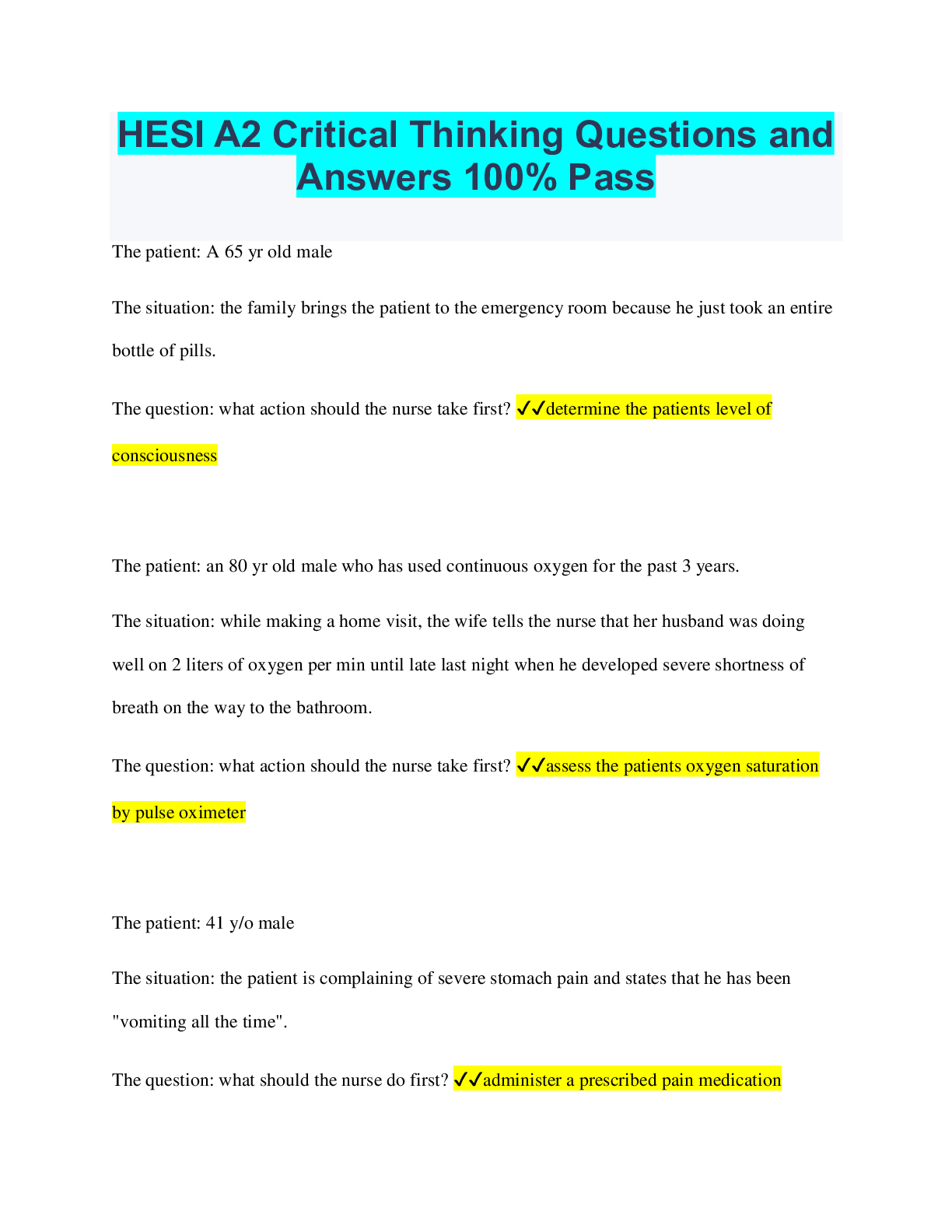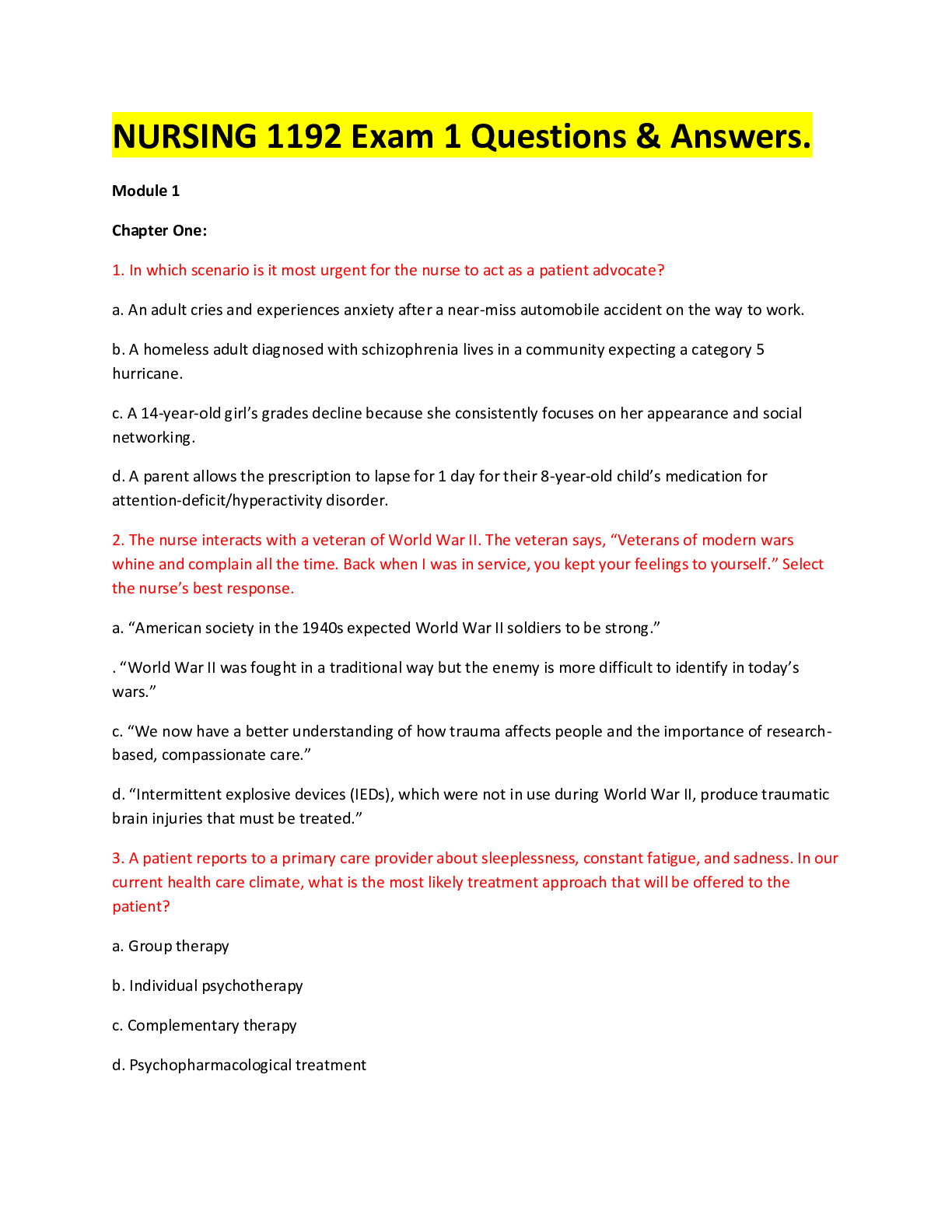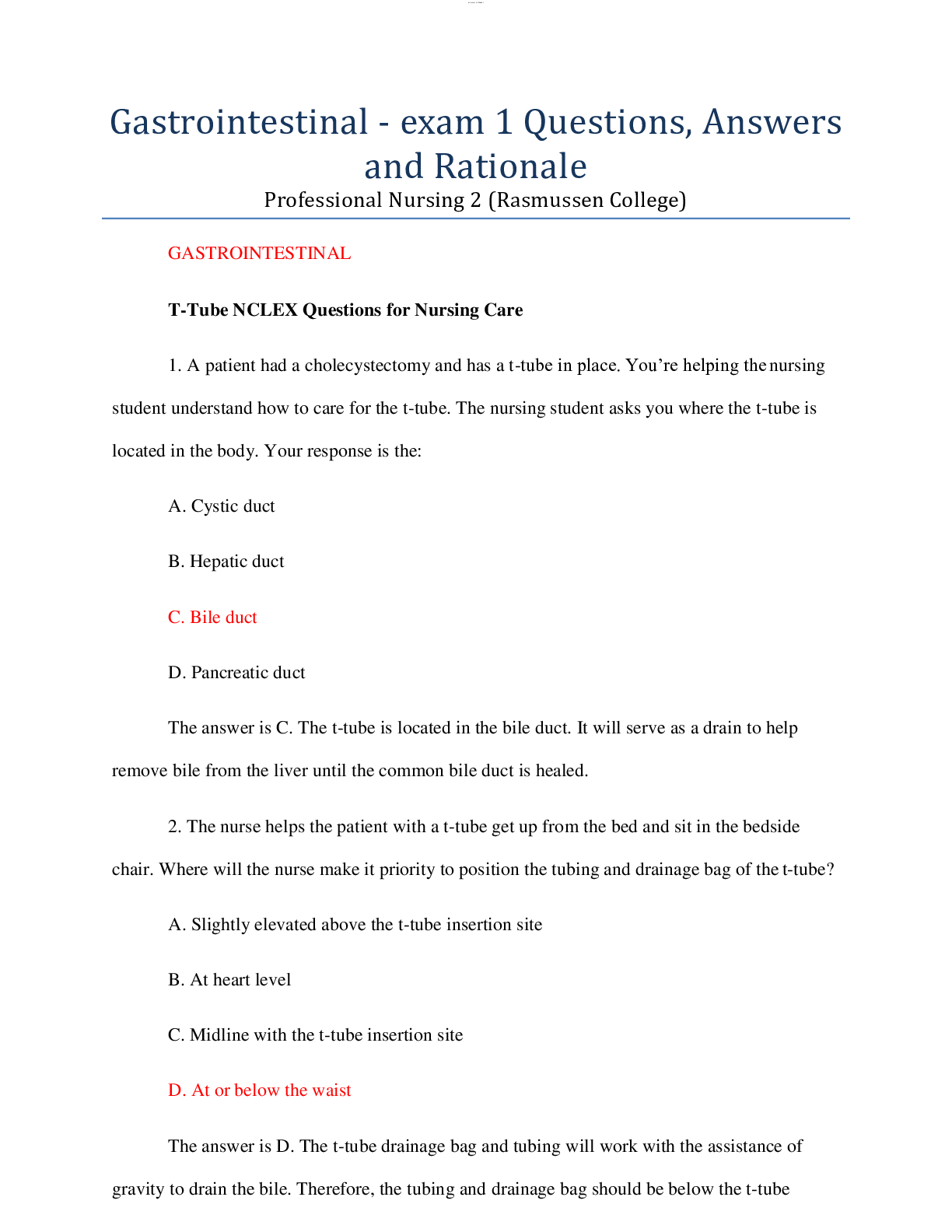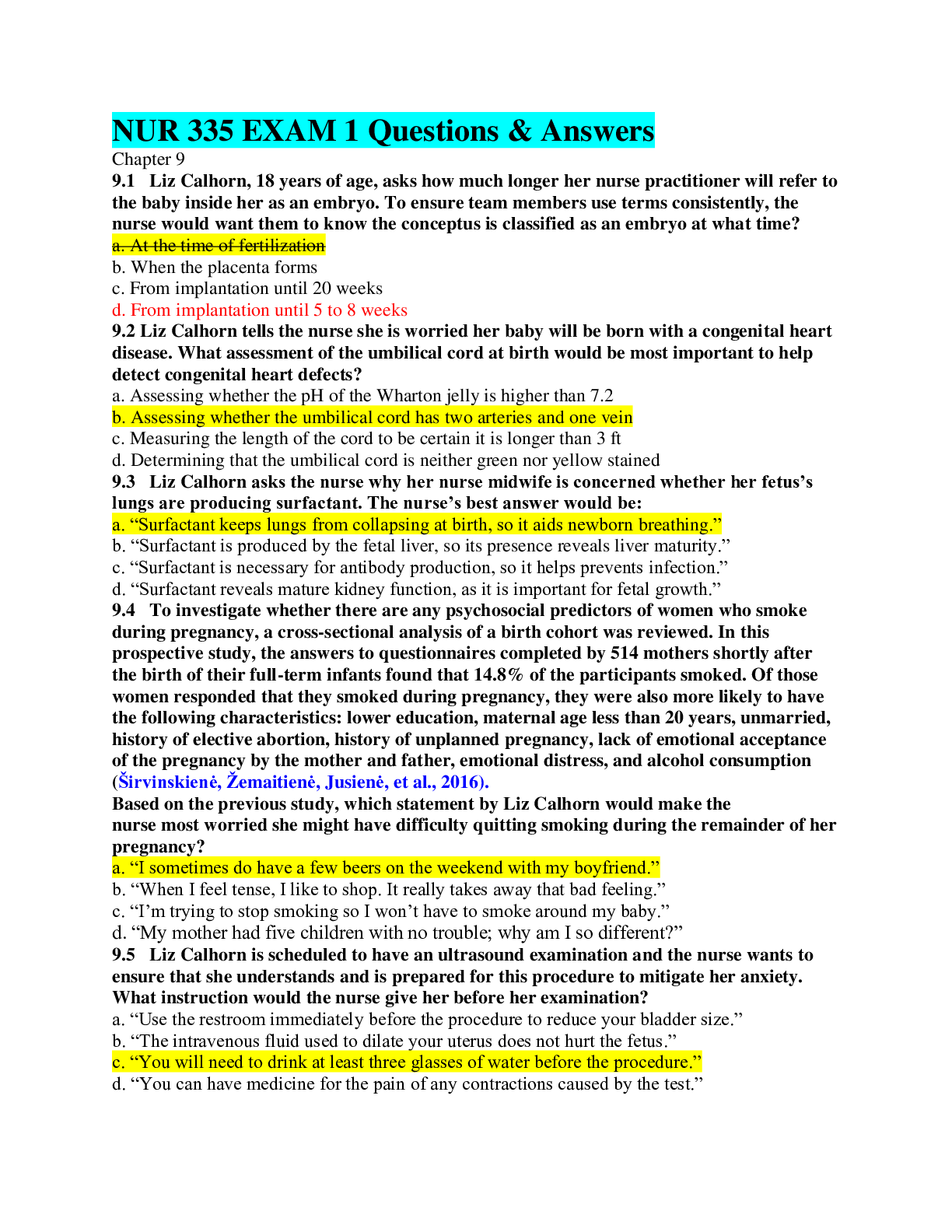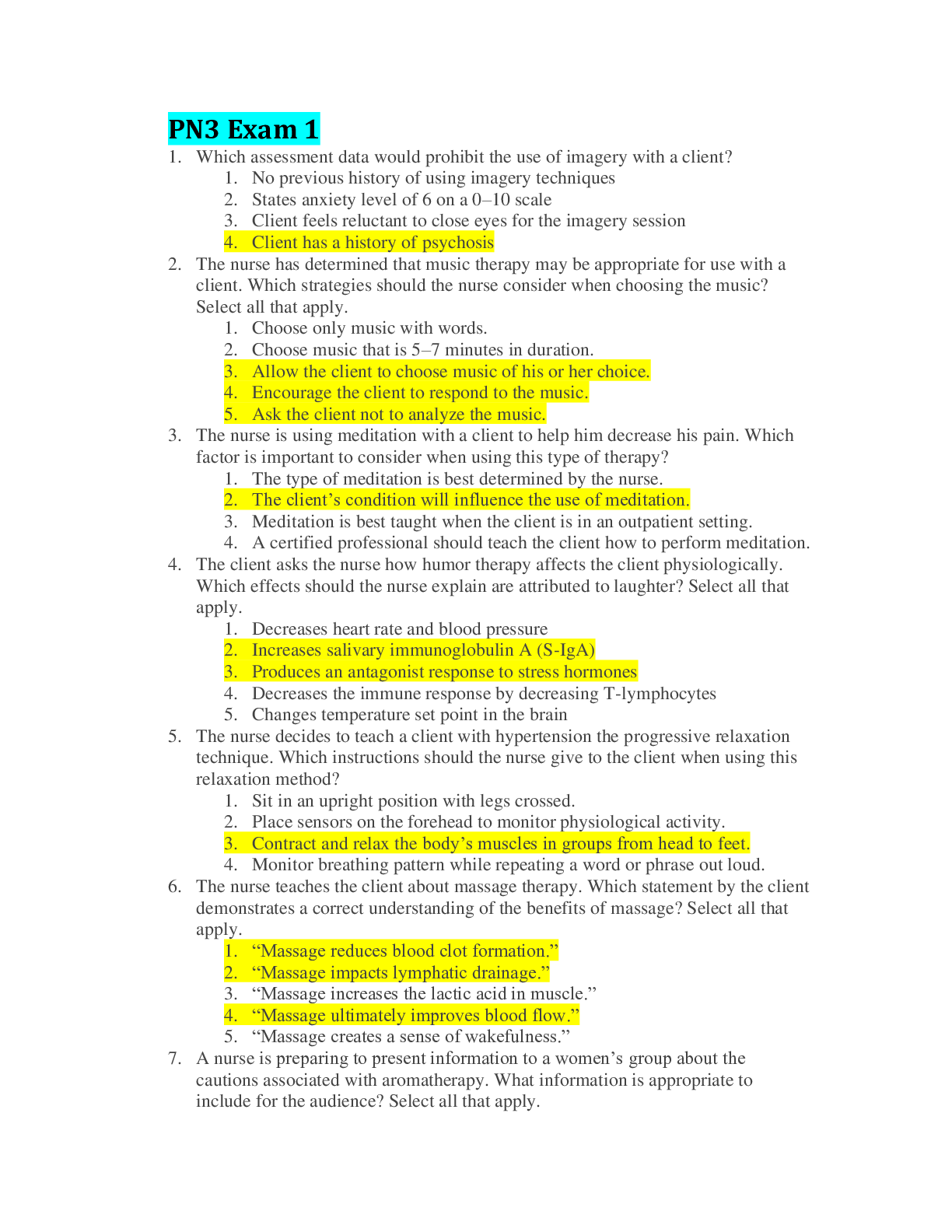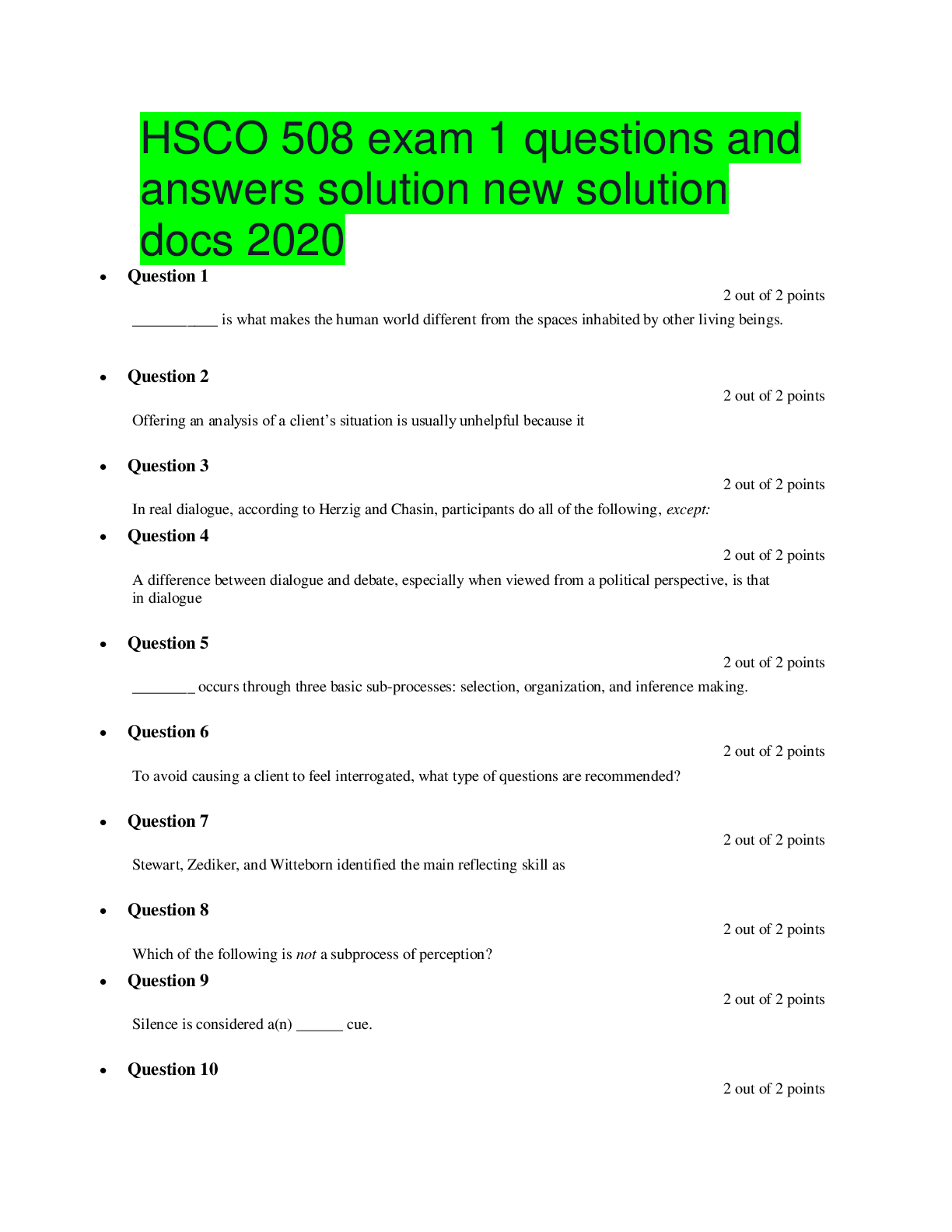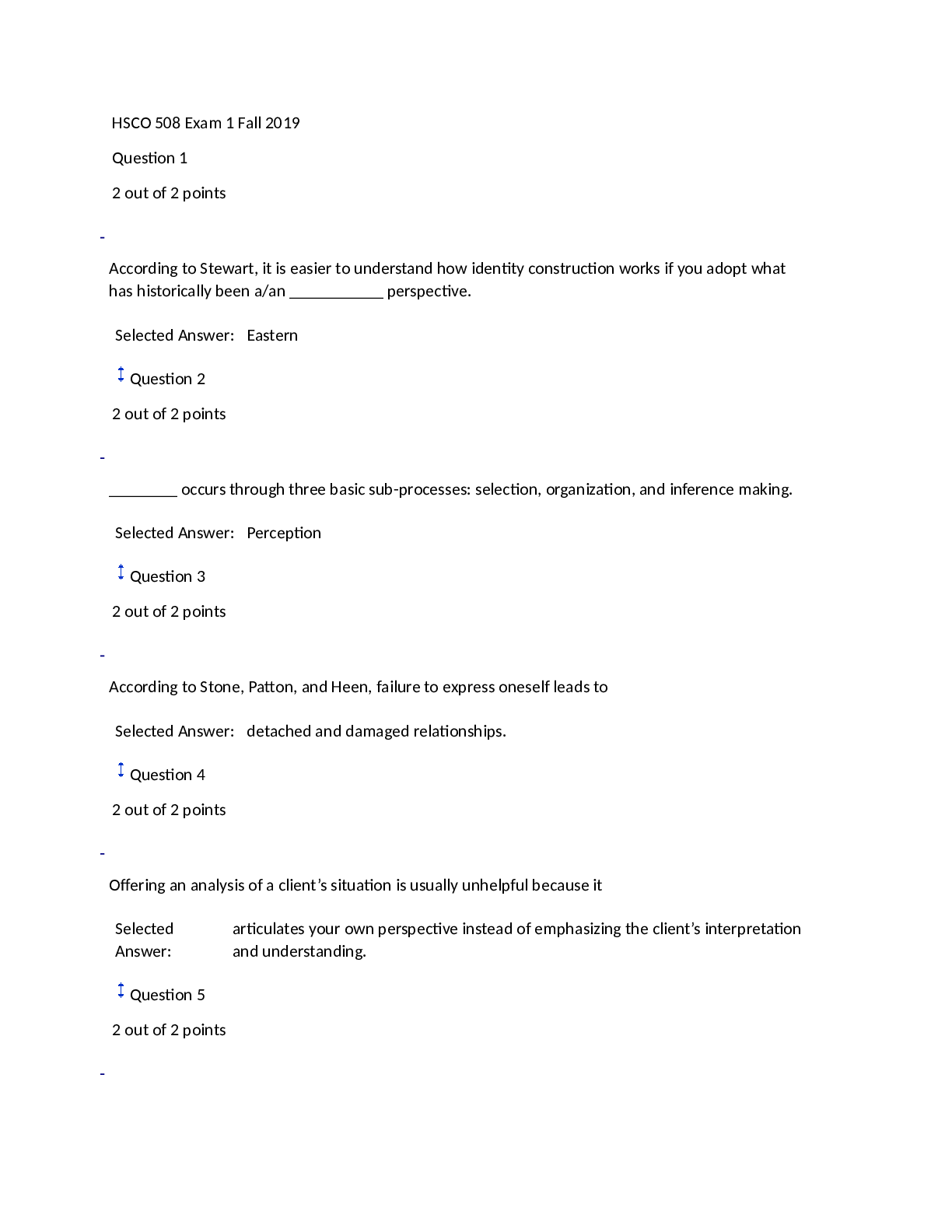Social Sciences > QUESTIONS & ANSWERS > Mock BCBA EXAM 1 Questions and Answers Already Graded A (All)
Mock BCBA EXAM 1 Questions and Answers Already Graded A
Document Content and Description Below
Mock BCBA EXAM 1 Questions and Answers Already Graded A Determinism ✔✔Cause and Effect, Lawfulness: If/Then statements. The world is orderly and predicable. Latency ✔✔The time between an S... D and the response: "Bryson get your shoes on (SD) - Bryson initiating getting his shoes on" The time from a reinforcer to the next response is a latency and not an IRT, even if the reinforcer is response-produced. Inner Response Time ✔✔The time from the start of one response (behavior) to the start of the next response (behavior). The time between two responses. 3 Branches of Behavior Analysis ✔✔1) Behaviorism 2) Experimental Analysis of Behavior 3) Applied Behavior Analysis Behaviorism ✔✔Behaviorism is the philosophy and theory of behavioral science, widely recognized due to the work of John B. Watson. Behaviorism was the predominate model in psychology from the early to mid 1900's and is based on the principle that psychology should be seen as a science. He argued that behavior is observable and should be objectively and scientifically measured. Watson was primarily concerned with the relationship between observable behaviors and environmental events rather than on internal processes. Experimental Analysis of Behavior (EAB) ✔✔the intensive study, under controlled conditions, of how environmental stimuli and consequences regulate an individual organism's behavior.This is operant behavior, behavior that is based on the consequences of that behavior. The creation of EAB showed that the environment creates learned behaviors and has a functional relation. It also allowed scientists to manipulate the environment in order to increase or decrease an operant behavior. The theory of EAB was a result Skinners findings of the S-R-S model or three-term contingency. ABA ✔✔Applied Behavior Analysis is a scientific-based field of study that uses behaviorism as its philosophy and aims to improve socially significant behaviors through experimentation. ABA is an applied science that develops methods of changing behavior, and also, a profession that provides services to meet diverse behavioral needs. resistance to extinction ✔✔Behavior that continues responding during the implementation of an extinction procedure. Ordinate ✔✔y-axis on a graph, Vertical abscissa ✔✔x-axis (horizontal) Exclusionary Time out ✔✔Individual removed from space. 3 Types: (RPH) 1. Room/Time-Out Room 2. Partition Time-Out 3. Hallway Time-Out Permant product recording ✔✔Recording tangible items or environmental effects that result from a behavior, for example, written academic work (also called outcome recording). DRL ✔✔Differential Reinforcement of Low Rates of Behaviors. Reinforcement schedule that is used to decrease the rate of behaviors that occur too frequently but should be maintained in the learner's repertoire DRH ✔✔Differential Reinforcement of High Rates of Behaviors. Reinforcer is delivered for more than a fixed number of responses in a time period -or- Reinforcer is delivered after an IRT less than some criterion amount of time. Used to increase behavior. A particular reinforcement schedule in which reinforcement is delivered for rates of responding ABOVE a specified predetermined criterion (based on the individual's performance in previous intervals). (e.g., more than three responses per 5 minutes). Discontinuous Measurement ✔✔measurement conducted in a manner such that some instances of the response class(es) of interest may not be detected Whole Interval Partial Interval Momentary Time Sampling Whole Interval Recording ✔✔involves checking off the interval if the behavior occurs throughout the WHOLE interval. Use when it is difficult to tell when the behavior begins or ends, when it occurs at such a high rate it is difficult to keep count. An under-exaggeration of behavior, you use this method to increase behavior. Underestimates behavior Partial Interval Recording ✔✔involves checking off an interval if the behavior occurs at ANY point within the interval - even if it only occurred for 1 second. You can use this for selfstimulatory behaviors or behaviors that don't look the same every time. An over exaggeration of the behavior, you use this method to decrease behavior. Underestimates Behavior and overestimates total duration. Momentary Time Sampling ✔✔A discontinuous response measure in which a response is recorded as occurring only if it occurs at the point in time in which an interval ends. Used for continous behaviors PLACHECK Planned activity check ✔✔teacher observation of a group of students and recording the number of students engaged in the target activity at the end of each time interval stimulus discrimination training ✔✔A behavior results in one consequence in a particular setting and another consequence in other settings. A process in which a behavior is reinforced when the discriminative stimulus (Sd) is present and is extinguished when the S-delta is present. As a result, the behavior is more likely to occur only when the Sd is present. Also called discrimination training. Response Discrimination ✔✔the tendency NOT to make similar responses to the same stimulus. In operant conditioning, discrimination refers to responding only to the discriminative stimulus and not to similar stimuli. For example, imagine that you have trained your dog to jump in the air whenever you say the command, "Jump!" Reversal Design ✔✔any experimental design in which the researcher attempts to verify the effect of the independent variable by "reversing" responding to a level obtained in a previous condition: encompasses experimental designs in which the independent variable is withdrawn. REMEMBER: this can only be used for behaviors in which it can not be UNLEARNED: Can not use this design for behaviors such as riding a bike, learning numbers, colors, ect as these can not be unlearned. response prompt ✔✔Modeling, physical guidance, verbal instructions, non vocal verbal instructions, written words, pictures, verbal instructions Stimulus prompts ✔✔Movement, redundancy, positioning level and trend ✔✔If data points overlap in Y axis there is no change in level. If same angle shown there is no change in trend. Bar Graph ✔✔Also called: HISTOGRAM: a graph that uses vertical or horizontal bars to show comparisons among two or more items Comfounding variable ✔✔unexpected factors influencing behavior during an intervention. Spider graph or all lines overlapping in an FA graph ✔✔Interpret that it is either sensory maintained behavior or not undetermined. Do not try to identify with lines overlapping. 6 Attitudes of Science/Philosophical Assumptions of Behavior ✔✔DEERPP: Determinism, Empiricism, Experimentation, Replication, Parsimony, Philosophical Doubt Determinism ✔✔the philosophy that holds that every event, action, and decision results from something independent of the human will. The world is orderly and lawful. Empiricism ✔✔the view that knowledge originates in experience and that science should, therefore, rely on observation and experimentation and not personal beliefs or emotions. Experimentation ✔✔making a reasoned analysis of an opportunity, envisioning potential solutions, evaluating those possibilities, and developing the most promising ones, consistent with the resources you have Replication ✔✔a) Repeating conditions within an experiment to determine the reliability of the effects and increase internal validity. parsimony ✔✔Requires all simple, logical explanations for the phenomenon under investigation be ruled out, experimentally or conceptually, before more complex or abstract explanations are considered philosophical doubt ✔✔Having a healthy skepticism and a critical eye about the results of studies and your work with clients. Scientist continually question the truthfulness of what is regarded as fact 3 Dimensional qualities ✔✔repeatability (Count, Rate, Frequency, celeration) temporal extent (duration), temporal locus (Response Latency, IRT) Temporal Extent ✔✔refers to the fact that every instance of behavior occurs during some amount of time (Duration) Temporal locus ✔✔every instance of behavior occurs at a certain point in time with respect to other events (Response latency, IRT) Prompts ✔✔Supplementary antecedent stimuli used to evoke a CORRECT response in the presence of an EO or Sd that will eventually control behavior HAS TO BE CORRECT TO BE CONSIDERED A PROMPT Procedural Fidelity ✔✔(treatment integrity) the extent to which the independent variable is applied exactly as planned and described and no other unplanned variables are administered inadvertently along with the planned treatment. Behavior Plan ✔✔A strategy to reduce maladaptive behaviors and increase prosocial behaviors; provides a framework for the therapeutic sessions and gives all practitioners a common set of knowledge by which to treat the client. A suggestion on how to reduce behaviors. Can not make individual follow it. Discontinous Measurement ✔✔measurement conducted in a manner such that some instances of the response class(es) of interest may not be detected 3 Recording methods: Wits, Pits, Mits: Whole interval, Partial -interval, Momentary time sampling continous measurement ✔✔conducted in a way in which ALL instances of a response class are detected during an observation period. 2 recording methods Frequency Duration DNRO ✔✔determines if the target behavior occurred during a specified interval of time. If it occurred, escape or avoidance is prevented and the interval is reset for the full DNRO period if the target behavior didn't occur, reinforcement in the form of termination of an unpleasant event or task is provided at end of the designated interval. NCR Formula ✔✔The delivery of Ex: -# of baseline sessions=3 -duration of each baseline session=60 mins -total # of bxs recorded during baseline sessions=10 3 x 60=180 then 180/10 =18, the initial NCR NCR Definition ✔✔1. response independent (i.e. time based) schedule of reinforcement 2. "response independent"=this means clt's responses are NOT dependent/contingent on anything. 3. providing stimuli w/ known reinforcing properties 4. on a fixed time (FT) or variable time (VT) schedule 5. independent of clt's bx Validity ✔✔data is valid when it is directly relevant to what is being measured and to the reasons for measuring it; measuring a socially significant target behavior, measuring a dimension of the target behavior, ensuring that the data represents the behaviors occurrence under conditions that are most relevant to the question about the behavior Accuracy ✔✔A description of how close a measurement is to the true value of the quantity measured. 7 Dimensions of ABA ✔✔Behavioral: (observable and measurable behaviors are targeted) Applied: (socially significant behaviors are selected) Technological: procedures are described clearly and concisely so that other may implement accurately Conceptually Systematic: interventions consistent with principles demonstrated in the literature Analytic: decisions are data based Generalization: skills/behavior occur in environments other than where they were discretely taught Effective: interventions are monitored to evaluate the impact on the target behavior behavior trap ✔✔using natural contingencies (potentially items of interest that may act as reinforcement) of reinforcement can operate to promote and maintain generalized behavior changes (such as increasing reading skills or math problems). Example: Student was scorning low in reading and math. Loved baseball. Used baseball player names to teach spelling and reading, hometown to learn geography ect. false negative (type 2) ✔✔not perceiving a stimulus that is present (when you are pregnant but the test says NO). fasle positive (type 1) ✔✔When you are not pregnant but it says you are. Reactivity ✔✔effects of an observation and measurement procedure on the behavior being measured. Reactivity is most likely when measurement procedures are obtrusive, especially if the person being OBSERVED is aware of the observer's presence and purpose. abative effect ✔✔A decrease in the current frequency of behavior that has been reinforced by the stimulus that is increased in reinforcing effectiveness by the same motivating operation EXAMPLE: food ingestion abates (decreases the current frequency of) behavior that has been reinforced by food). observer drift ✔✔Any unintended change in the way an observer uses a measurement system over the course of an investigation that results in measurement error cumulative graph ✔✔A graph on which the number of occurrences of behavior observed in a given session is added to the number of occurrences of previous sessions in order to derive the data points to be plotted. DATA WILL ALWAYS INCREASES OR STAYS CONSTANT Default Technologies ✔✔coercive, punishment based interventions that are often selected arbitrarily- Punishment does not always fit crime- not generally function based "go to your room" Stimulus salience ✔✔the prominence of the stimulus in the persons environment. Ex. room color, therapist (Making study material bright and colorful) abscissa ✔✔X-AXIS Ordinate ✔✔y-axis Point-to-point correspondence ✔✔A relation between the stimulus and response or response product that occurs when the beginning, middle, and end of the verbal stimulus matches the beginning, middle, and end of the verbal response. high variability in a graph shows ✔✔Independent variable has little or no effect explanatory fiction ✔✔a fictitious or hypothetical variable that often takes form of another name for the observed phenomenon it claims to explain and contributes nothing to a functional account or understanding of the phenomenon, such as "intelligence" or "cognitive awareness" as explanations for why an organism punches the lever when the light is on and food is available but does not push the lever when the light is off and no food is available. Look for words such as "In the past" Fixed Ratio ✔✔Post reinforcement pause with high steady rate Reversal design can be unethical due to ✔✔the fact that it goes back to baseline to prove IV is effective and prob bx will continue in baseline Baseline Logic & Its Elements ✔✔Prediction Replication Verification [Show More]
Last updated: 2 years ago
Preview 1 out of 15 pages
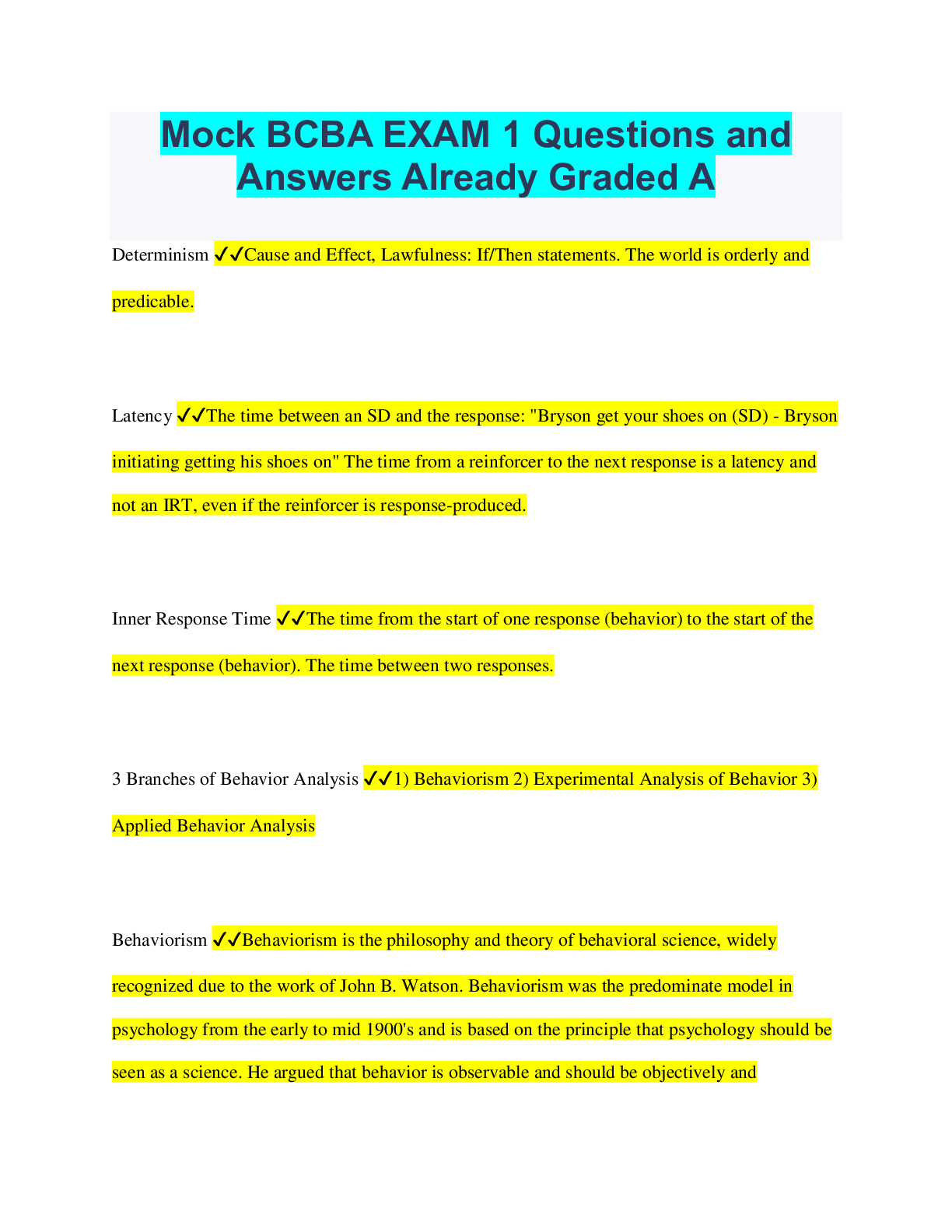
Buy this document to get the full access instantly
Instant Download Access after purchase
Buy NowInstant download
We Accept:

Also available in bundle (1)

BCBA BUNDLED EXAMS QUESTIONS AND ANSWERS WITH VERIFIED SOLUTIONS
BCBA BUNDLED EXAMS QUESTIONS AND ANSWERS WITH VERIFIED SOLUTIONS
By Nutmegs 2 years ago
$22
14
Reviews( 0 )
$10.00
Can't find what you want? Try our AI powered Search
Document information
Connected school, study & course
About the document
Uploaded On
May 10, 2023
Number of pages
15
Written in
Additional information
This document has been written for:
Uploaded
May 10, 2023
Downloads
0
Views
99












